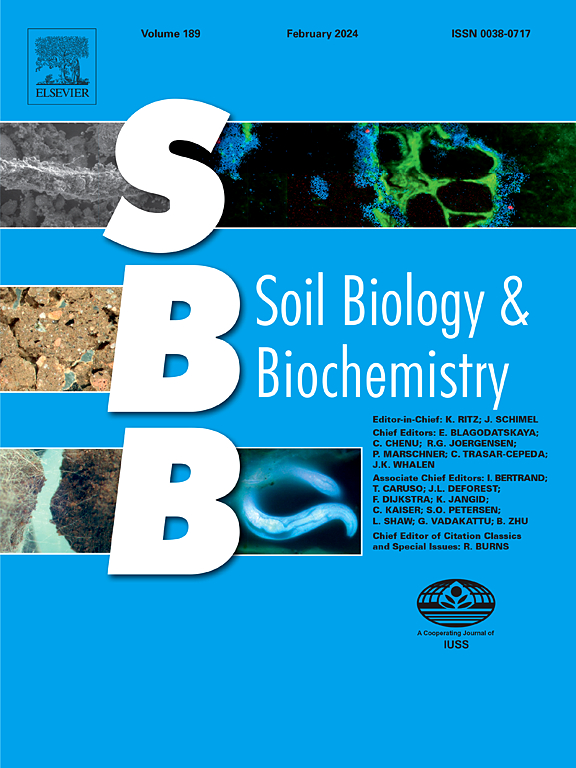响应二氧化碳升高的全球土壤呼吸荟萃分析
IF 9.8
1区 农林科学
Q1 SOIL SCIENCE
引用次数: 0
摘要
土壤呼吸(Rs)是陆地生态系统碳循环的重要组成部分,对大气CO2浓度具有重要的调节作用。虽然以前的研究已经提出了大气CO2浓度上升对Rs的潜在影响,但这些研究大多局限于CO2暴露技术的地理分布和可变性。在全球范围内,特别是在不同的气候条件和植被类型中,导致Rs对二氧化碳(eCO2)升高的响应仍然知之甚少。本研究综合了207篇已发表的eCO2实验研究中的1191个配对观察结果,以量化Rs及其相关因子对eCO2的响应。结果表明,eCO2显著提高了根系生物量(32%)、土壤有机碳(SOC)和土壤水分(SWC)含量(9.6%),导致土壤Rs总体增加了23%。此外,不同气候条件和植被类型下,eCO2对Rs的影响存在显著差异。由于气候条件的差异,湿润地区eCO2对Rs的积极影响(26%)高于干旱区(14%)。此外,eCO2对森林生态系统Rs的增加(28%)高于草地生态系统(15%)。此外,Rs与eCO2的大小呈正相关。然而,Rs对eCO2持续时间的响应呈凸关系,表明CO2对Rs的积极影响可能随着实验持续时间的延长而减弱。研究结果表明,在不同的生态系统和气候区域,eCO2对Rs的影响存在显著差异。本研究为提高土壤碳循环模型的准确性和有效的气候变化政策提供了科学依据。本文章由计算机程序翻译,如有差异,请以英文原文为准。


A global meta-analysis of soil respiration in response to elevated CO2
Soil respiration (Rs) is a crucial component of the terrestrial ecosystem carbon (C) cycle, which significantly regulates atmospheric CO2 concentrations. Although previous studies have suggested potential impacts of rising atmospheric CO2 concentrations on Rs, most of these studies are limited in geographic distribution and variability in CO2 exposure techniques. Globally, particularly across climatic conditions and vegetation types, resulting in the response of Rs to elevated CO2 (eCO2) remains poorly understood. In this study, 1191 paired observations from 207 published experimental eCO2 studies were synthesized to quantify the response of Rs and its related factors to eCO2. The results showed that eCO2 significantly increased root biomass (32%), soil organic carbon (SOC, 3.6%), and soil water content (SWC, 9.6%), leading to an overall increase in Rs by 23%. Moreover, the impacts of eCO2 on Rs varied significantly across climate conditions and vegetation types. The positive effects of eCO2 on Rs in humid regions (26%) were higher than that in arid regions (14%), primarily due to differences in climatic conditions. Furthermore, eCO2 increased Rs in forest ecosystems (28%) was higher than that in grassland ecosystems (15%). Additionally, Rs was positively correlated with the magnitude of eCO2. However, the response of Rs to eCO2 duration exhibited a convex relationship, indicating that the positive effect of CO2 on Rs may diminish when extended experimental durations. Our findings suggest that the effects of eCO2 on Rs will vary significantly across ecosystems and climate regions. In summary, our study provides a scientific basis for enhancing the accuracy of soil C cycling models and informing effective climate change policies.
求助全文
通过发布文献求助,成功后即可免费获取论文全文。
去求助
来源期刊

Soil Biology & Biochemistry
农林科学-土壤科学
CiteScore
16.90
自引率
9.30%
发文量
312
审稿时长
49 days
期刊介绍:
Soil Biology & Biochemistry publishes original research articles of international significance focusing on biological processes in soil and their applications to soil and environmental quality. Major topics include the ecology and biochemical processes of soil organisms, their effects on the environment, and interactions with plants. The journal also welcomes state-of-the-art reviews and discussions on contemporary research in soil biology and biochemistry.
 求助内容:
求助内容: 应助结果提醒方式:
应助结果提醒方式:


